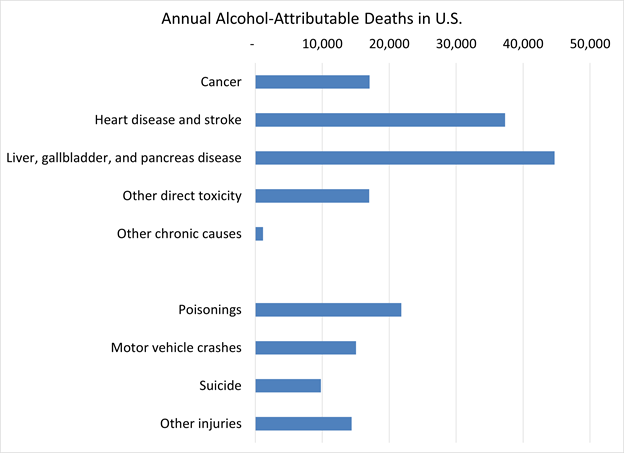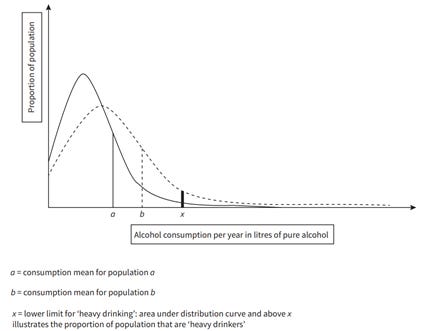You may be tired of reading about how Robert Kennedy, while pretending to be a health activist, is instead working to harm our health. But there is one target of his that I feel obligated to write about because others haven’t.
Kennedy talks about protecting Americans from exposure to toxic chemicals. But his HHS reorganization would shut down CDC’s program to protect people from a pervasive and immensely destructive toxin: alcohol.
If you don’t think of alcohol as a toxic chemical, think again. Ethanol and its metabolites kill liver cells and brain cells. Alcohol causes cancer, not just in lab mice but also in humans. And if you consume alcohol, you become, well, “intoxicated” and are more likely to harm yourself or others.
CDC estimates that alcohol kills 178,000 Americans a year, from causes as diverse as car crashes, cirrhosis, stroke, suicide, homicide and cancer.

A public health problem that large deserves a serious attempt to limit the damage. We don’t have that in this country.
The National Institute of Alcohol Abuse and Alcoholism (NIAAA) funds research on alcohol’s biologic effects and approaches to treatment of alcoholism. SAMHSA gives money to states to treat people addicted to alcohol. But to protect the rest of us from alcohol’s harms, CDC has only a $6 million program - an investment of less than 2 cents per American.
What do CDC staff do with that money?
They maintain ARDI, an online tool that produces estimates like those in the graph above of the deaths attributable to alcohol.
They put out evidence-based recommendations for what states and localities can do to limit the damage.
They give small grants to 11 state health departments to track alcohol’s impacts locally, set up their own data dashboards, and convene groups that advocate for healthier policies.
In short, the CDC dollars pay to distribute information – messages that say alcohol is bad for all of us and that explain what could help. Mostly those messages are buried or fall on deaf ears, but maybe someday people will listen and do something with them.
What would make a difference?
Neither CDC nor anyone else is proposing that we re-institute Prohibition. But a few proven policies could cut back on the many people who drink to excess and the damage alcohol causes. Those policies include:
Raising taxes on beer, wine, and spirits
Limiting the number or density of liquor stores and bars
Holding bar owners responsible for injuries caused by their selling alcohol to intoxicated customers
Limiting the days or hours during which businesses can sell or serve alcohol
Not privatizing the sales of alcohol where it is now sold only in “state stores”
Enforcing the prohibition of sales to those under age 21
Of these, the most straightforward and effective policy is raising alcohol taxes.
Alcohol behaves just as economists would predict. When prices fall, people buy and drink more; when they rise, people drink less. For example, here are trends in alcohol prices and sales in Ukraine in the years before the Russian invasion.
On average, a 10% rise in the price of alcohol leads to about a 5% fall in sales of beer, 7% fall in sales of wine, and 8% fall in sales of spirits. Alcohol price increases also lead to significant drops in the damage from drinking, including child abuse and deaths from cirrhosis, car crashes, suicide, and violence.
Why would a price-related fall in average alcohol consumption affect these extreme outcomes, which mostly arise from heavy drinkers? One theory is that, faced with higher prices, society as a whole adjusts. The entire distribution curve of drinking shifts to the left (from b to a in the hypothetical diagram below): infrequent and average drinkers drink less, and fewer people remain heavy drinkers (that is, drinking more than x).

So, raising the prices of booze could prevent many of those deaths from drinking. If you’re a heavy drinker you’d be less likely to crash your car or die in a gun fight, if you’re a light drinker you’d be less likely to get cancer, and if you’re a nondrinker you’d be less likely to get hit by a drunk driver. Politics aside, raising the price is easy to do, with higher alcohol excise taxes at the federal, state, or local level.
The loss of CDC’s alcohol program
It must be lonely for the CDC staff who work in the alcohol program. They have just a few colleagues, unlike the hundreds who work to prevent HIV infection or to get kids vaccinated. They answer to elected officials who range from uninterested to hostile to ideas like alcohol taxes. (Most politicians drink, and even those who don’t drink dare not offend their beer-, wine-, or cocktail-drinking voters.) And they have to compete with a tsunami of pro-alcohol messages, from the beer ads during football games to New York Times stories on how to mix cocktails.
But the CDC folks have soldiered on. Now, Kennedy wants to fire them all. That is, he wants to kill the messenger. No more inconvenient truths like those 178,000 deaths.
It may take years to notch a public health win on alcohol. But it’s worth $6 million a year for CDC to keep trying. At least that’s my 2 cents.
Bonus: A great video op-ed on alcohol taxes.






I have always been confused about the legal status of alcohol and tobacco.
They strongly resemble Schedule 1 drugs and are both strongly deleterious to the users health yet… they are solidly legal.
Go figure…
And he's done the same thing to that other toxin - tobacco! Seems there's no chronic diseases from either of these toxins!